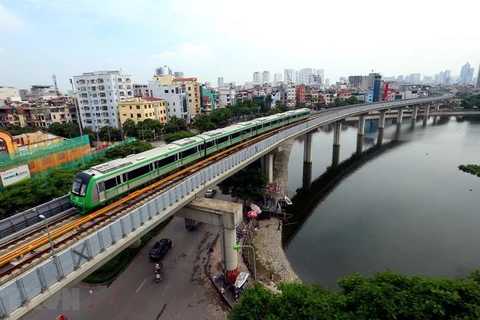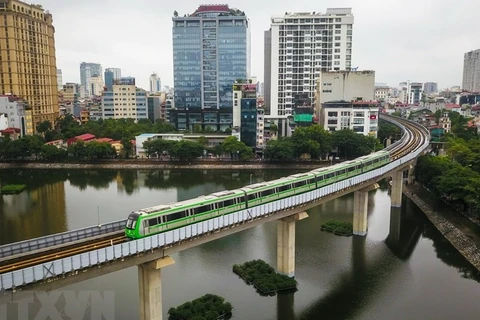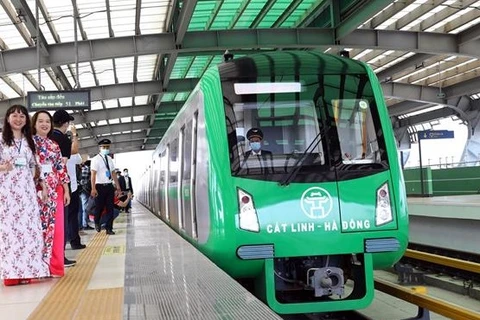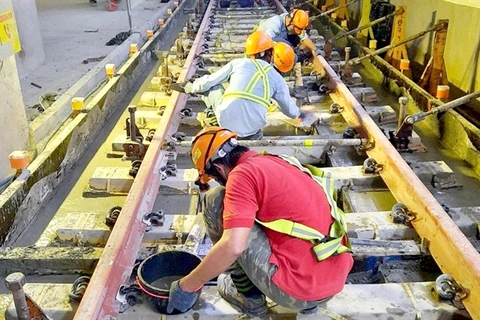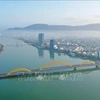Hanoi (VNA) - Trains on the Nhon-Hanoi Train station metro lines were put on a trial run at a maximum speed of 80km per hour on December 6 morning.
The speed was pushed to the maximum to check the operation quality as well as the synchronisation between the information, signals, and control systems, according to the Metropolitan Railway Management Board (MRB).
The 12-kilometre Nhon-Hanoi Station metro line starts from Nhon in Nam Tu Liem district and ends at the Hanoi Station in Dong Da district, and includes eight elevated stations and four underground.
The trains departed from the S1 Station (Nhon) and ran to S8 Station (Cau Giay district) and returned. The distance between the two stations is 8.5 km.
The designed maximum speed of the trains is 80km per hour. But in reality, it is hard for the train to increase to that speed because the distance between two stations is around 1km, according to the MRB.
The average speed of the trains will be 35km per hour and the trains could reach a speed of up to 70km per hour at the middle of the two stations, the MRB said.
The trial run at the maximum speed is important to examine the operational quality of the trains and assess safety.
Once fully operational, eight trains will be officially in service, with one used to ease overloading at peak hours.
Each train is designed to carry between 944 and 1,124 passengers. The trains are designed and manufactured by France's Alstom company.
The project's investment of about 30.1 trillion VND (1.29 billion USD) comes from official development assistance of the French Development Agency and loans from the French Government.
The urban railway line No 3, connecting Nhon area and the Hanoi Station, will run through Nam Tu Liem, Bac Tu Liem, Cau Giay, Ba Dinh, Dong Da and Hoan Kiem districts.
The elevated section is slated for commercial operation by the end of this year, while the remaining part which is underground will be put into use next year./.
The speed was pushed to the maximum to check the operation quality as well as the synchronisation between the information, signals, and control systems, according to the Metropolitan Railway Management Board (MRB).
The 12-kilometre Nhon-Hanoi Station metro line starts from Nhon in Nam Tu Liem district and ends at the Hanoi Station in Dong Da district, and includes eight elevated stations and four underground.
The trains departed from the S1 Station (Nhon) and ran to S8 Station (Cau Giay district) and returned. The distance between the two stations is 8.5 km.
The designed maximum speed of the trains is 80km per hour. But in reality, it is hard for the train to increase to that speed because the distance between two stations is around 1km, according to the MRB.
The average speed of the trains will be 35km per hour and the trains could reach a speed of up to 70km per hour at the middle of the two stations, the MRB said.
The trial run at the maximum speed is important to examine the operational quality of the trains and assess safety.
Once fully operational, eight trains will be officially in service, with one used to ease overloading at peak hours.
Each train is designed to carry between 944 and 1,124 passengers. The trains are designed and manufactured by France's Alstom company.
The project's investment of about 30.1 trillion VND (1.29 billion USD) comes from official development assistance of the French Development Agency and loans from the French Government.
The urban railway line No 3, connecting Nhon area and the Hanoi Station, will run through Nam Tu Liem, Bac Tu Liem, Cau Giay, Ba Dinh, Dong Da and Hoan Kiem districts.
The elevated section is slated for commercial operation by the end of this year, while the remaining part which is underground will be put into use next year./.
VNA

